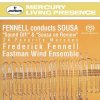D
Deleted member 133
Guest
A few weeks back Rammis and I exchanged posts in a thread. We were discussing RCA's "Dynagroove" technology.
That planted a seed: I needed to finally get around to cataloging and entering my Dad's record collection into my music database.
So I've been doing so on this rainy Friday afternoon - album by album.
A lot of these albums date from the late '50s through to the early '60s. At that time there was apparently a lot of jockeying for market share through the use of new stereo technologies. Many albums have more space dedicated on their covers and liners to recording techniques and technologies than to the artist(s) music.
One that I'm just now processing involves Mercury Records' "f:35d" - "Perfect Presence Sound marks a new film breakthrough in sound engineering. Only Mercury's f:35d recording technique can achieve 'infinite depth' in the widest range of authentic sound possible. Original recording made on 35 mm film."
That last bit is new to me - at least from a purely sound recording perspective.
It turns out the "35 mm film" is three track 35 mm magnetic film - with the following claimed recording advantages (which I summarize):
1. There is no tape hiss.
2. No flutter.
3. No cross-talk between recording channels
4. Less danger of print-through in storage
5. Better transient response and greatly extended frequency range due to 18 ips film speed.
Kinda cool.
It would be neat if I could find some of those recordings in HD digital (of some sort), preferably in original 3.0, or even stereo CD, transferred directly from the source film. I'll do some searching as time permits.
Jeff
That planted a seed: I needed to finally get around to cataloging and entering my Dad's record collection into my music database.
So I've been doing so on this rainy Friday afternoon - album by album.
A lot of these albums date from the late '50s through to the early '60s. At that time there was apparently a lot of jockeying for market share through the use of new stereo technologies. Many albums have more space dedicated on their covers and liners to recording techniques and technologies than to the artist(s) music.
One that I'm just now processing involves Mercury Records' "f:35d" - "Perfect Presence Sound marks a new film breakthrough in sound engineering. Only Mercury's f:35d recording technique can achieve 'infinite depth' in the widest range of authentic sound possible. Original recording made on 35 mm film."
That last bit is new to me - at least from a purely sound recording perspective.
It turns out the "35 mm film" is three track 35 mm magnetic film - with the following claimed recording advantages (which I summarize):
1. There is no tape hiss.
2. No flutter.
3. No cross-talk between recording channels
4. Less danger of print-through in storage
5. Better transient response and greatly extended frequency range due to 18 ips film speed.
Kinda cool.
It would be neat if I could find some of those recordings in HD digital (of some sort), preferably in original 3.0, or even stereo CD, transferred directly from the source film. I'll do some searching as time permits.
Jeff




